Heating batteries: selection assistance, problems and
What could be the heating battery? What materials are used for the manufacture of heating devices? What to do if the heating battery leaked between the sections or on the liner? In our material we will try to find answers to these and many other questions.
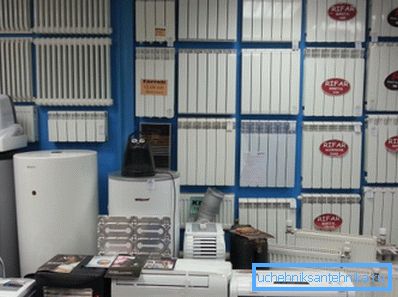
Classification
Let's find out by what signs modern heating batteries can be classified.
Material
For the production of heating devices can be used:
- Cast iron. Characteristic features of cast-iron sectional radiators of heating - a large internal volume of the section and considerable weight. The brittleness of cast iron limits the maximum working pressure in the heating system to a value of 9-12 atmospheres.
By the way: in the normal mode of operation of central heating, the pressure in the circuit does not exceed 4 - 4.5 atmospheres. For a private house with an autonomous contour, even more modest values are typical - 1.5 - 2 kgf / cm2.
- Steel. Its main advantage is mechanical strength, which allows not to be afraid of exceeding the calculated pressure values. The main disadvantage is the instability to corrosion; resetting the heating system for the summer significantly reduces the life of the heaters.
- Aluminum. The highest thermal conductivity of the metal is adjacent to the limited mechanical strength. In addition, aluminum forms a galvanic couple with copper; If aluminum batteries are used - the heating should not be diluted with copper pipes.
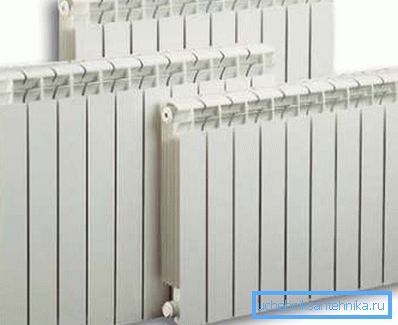
Along with the construction of one metal on sale can be found bimetallic products.
Two types of bimetallic heaters are common:
- Sectional or solid steel core radiators with aluminum sheath. Steel provides the highest resistance to internal pressure (including hydraulic shocks), and aluminum with its high thermal conductivity allows the heater to be equipped with fins with a large surface area. One of the champions in performance - the monolith radiator from the Russian company Rifar - is designed for a working pressure of 100 atmospheres.
- Copper-aluminum convectors have high heat emission in compact sizes. Copper is even more conductive than aluminum; the convector is a copper tube with a coolant, which are pressed on aluminum fins.
Finally, it is worth mentioning relatively rare exotics. Plastic radiators are bulky, fragile and able to perform their functions at temperatures not higher than +80 C. Working pressure can reach only 2 kgf / cm2; however, the price of such products is slightly higher than that of aluminum sectional batteries.
As the main advantage, manufacturers and sellers mention a small weight of the heater (which, in general, has at least some value only at the stage of transportation and installation).
The so-called ceramic batteries are not at all related to water heating. These are electric heating devices that warm the room not by convection, but by the transfer of heat by infrared radiation.
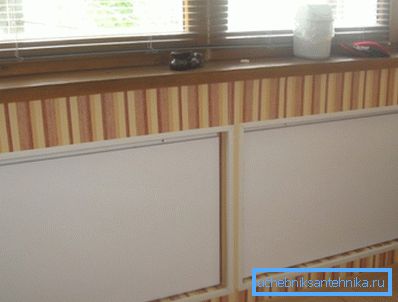
Type of
What are the heating devices on the design?
- Sectional heating radiators are batteries used in all houses of Soviet construction, and their more modern aluminum and bimetallic counterparts. They are convenient because they allow the addition of additional sections to flexibly vary the thermal capacity. But the gaskets between the sections often cause leaks.
- Convector. In essence, they are just a few turns of a pipe with transverse ribs pressed onto it, which increase heat transfer. Decorative covers and movable screens are often installed on the convector to limit heat transfer.
- Lamellar (flat) radiators are two steel figured plates welded along the contour. The coolant moves along the passages between them. They occupy a minimum of space in the room; However, low tensile strength and modest service life (for domestic plates - only 7 years) make the plate radiator a questionable acquisition.
- Registers (tubular batteries) are home-made or factory-made heating devices, which are a series of horizontal or vertical steel pipes connected by bridges of smaller diameter.
The moderate surface area and the low thermal conductivity of steel make the registers become quite overall; They are usually used for heating garages, workshops and industrial premises.
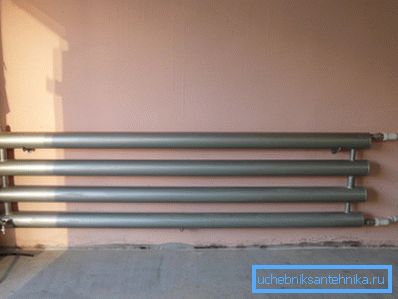
Dimensions
The most common batteries for heating, having a center distance on the liner, equal to 500 millimeters.
However, the range of the modern market is not limited to them.
- Low (up to 400 mm) heaters are used with panoramic windows and low window sills.
- Significant (800 - 2400 mm) vertical dimensions of radiators are needed where there is a need for high heat output with a shortage of space.
Installation method
Most radiators are designed for wall mounting. The bracket is attached to the wall with dowels, using a mounting gun, or screws; one radiator requires from 3 to 7 brackets depending on the mass and number of sections.
Floor heaters, as the name implies, are installed on a horizontal surface on the legs. They are in demand in cases where the walls have a low bearing capacity (aerated concrete, shell, vulture panels, and so on).
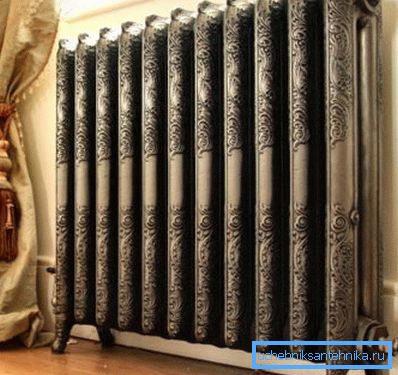
Manufacturers
As well as in the whole market of heating equipment, among manufacturers of heating devices the most highly rated are German and Italian brands.
In some cases, their preference is justified: for example, Kermi panel steel radiators are indeed stronger and more durable than domestic steel lamellar plates. However, with bimetallic and aluminum devices the picture is different.
Let's compare the main characteristics of the two heating devices: the already mentioned domestic Rifar Monolith and the Italian Global Style Plus 500.
| Parameter | Rifar | Global |
| Operating pressure, kgf / cm2 | 35 | 100 |
| Operating temperature, C | 135 | 110 |
| Heat flow to 1 section, watts | 196 | 185 |
| Section cost, rubles | 800 | 1050 |
To clarify: in the case of a monolithic radiator from Rifar, the division into sections is, of course, conditional.
It is not difficult to draw conclusions from these figures. The domestic product surpasses the import analog in all respects; while it is also 25% cheaper. Obviously, when choosing a heating device, it is better to look not at the brand, but at the characteristics.
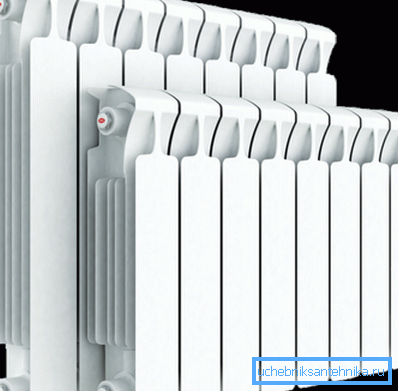
Payment
House
How many batteries do I need to heat a house of a known size?
Instructions for calculating the total heat output for a room are reduced to the following formula: Q = V * Dt * k / 860. In this formula, V is the outer (in size) volume of the house, Dt is the calculated temperature difference with the street, and k is the coefficient of warming.
How is the parameter Dt calculated and where will k be taken from?
In the first case, the difference between the standard value of the internal temperature (+18 - +22 С) and the average temperature of the coldest five days in the heating season is taken. Say, with an average minimum of -22 and a temperature maintained in the house of +20 C Dt = 20 - -22 = 42 C.
In the second, the coefficient is derived by linear interpolation from the following table:
| Warming | Coefficient |
| Foam coat, triple glazed windows | 0.6-0.9 |
| Brick 40 cm, double glazed windows | 1 - 1.9 |
| Brick 25 cm, wooden windows | 2 - 2.9 |
| Brick 12 cm, single thread glazing | 3 - 4 |
For example, for a well-insulated house (k = 0.8) with a volume of 300 m3 and an average January minimum temperature of -32 C, the need for heat output in kilowatts will be 300 * (20 - -32) * 0.8 / 860 = 14.5 KW
Apartment
In the case of an apartment with a standard ceiling height (2.5 - 3 meters), it is easier to adhere to the norm laid down in SNiPs half a century ago: one kilowatt of heat corresponds to an area of 10 m2. If the apartment has an area of 50 m2 - for its heating you need 5 kilowatts. The need for heat for an individual room is similarly estimated.
Heating appliances
Selection of the number of sections with a known need for heat is reduced to solving the simplest equation: for example, 2 kilowatts of heat can provide 10 sections with a heat flux of 200 watts.

Where to get data on the heat flow section? In the general case - from the technical documentation on the manufacturer's website.
If for some reason it is impossible, you can rely on the following values:
- Cast iron section gives 140 - 160 watts;
- Bimetallic - 180 watts;
- Aluminum - 200 watts.
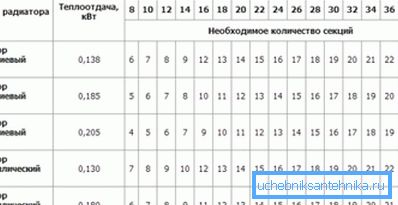
Technical issues
During installation, maintenance and repair of heating systems with their own hands a beginner may have a number of problems, with the solution of which we will try to help.
Installation
Which pipes are better to use for connecting batteries? In the central heating system - black steel in welding, galvanized on threads or corrugated stainless steel on fittings. In an autonomous system, it is better to make a serial connection of heaters with reinforced aluminum foil polypropylene; collector distribution in the floor is often made of cross-linked polyethylene.
How to connect a sectional radiator to the supply line? With a small number of sections (up to seven), a side one-way connection is used. With a larger number of sections, it is better to connect the battery diagonally or bottom to bottom.

Is it possible to install a battery on a balcony or loggia? Like any change in utilities, this requires coordination with the residents and the heating networks. In general, it is not possible: an additional device will reduce the heat transfer of the neighbors' batteries.
Repairs
How to remove the old cast-iron battery installed on the brackets?
- The riser is reset.
- On the liner, the lock nuts and radiator plugs are unscrewed in series. At resistance, the eyeliner is preheated by a hairdryer, blowtorch or torch.
- A socket wrench unscrews the radiator retaining nuts.
How to disassemble a sectional radiator?
- The radiator measures the distance from the plug to the corresponding nipple.
- The radiator key is inserted into the battery to this depth and rotates with a lever, and after the threads are touched - manually. The direction of the thread can be viewed on the cork through which the key is inserted.
Important: twin nipples are unscrewed one or two turns at a time. Skewing will break the nipple.

Why there is a leak between sections? Gaskets between sections lose their elasticity over time. To eliminate the leak, tighten the nipple.
Why is the battery connection to the connection flowing?
- Burnt coil on the lock nut. To eliminate the locknut you need to rewind when the riser is dropped.
- Sgon rusted on the thread. The connection area is changed with welding or manual threading.
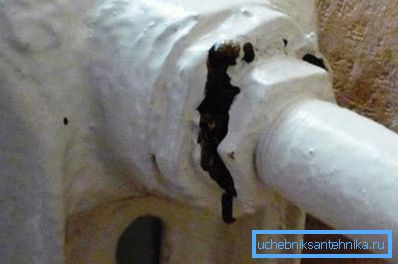
How to clean the radiator from clogging up its sludge? Flushing requires a flushing tap in the end cap. Through it, the water is discharged into the sewer before the extreme sections are heated. By the way, if your batteries are noisy - it’s likely that someone from the neighbors was puzzled right now by washing them.
What taps to put on liner and battery?
- At the pitch, a shut-off ball valve is placed.
- On the return pipe is mounted a choke (manual regulator of terrain) or a thermostat (thermal head).
- At the lower connection and on the upper floors in houses with lower bottling, an air vent is placed in the upper radiator plug (a Mayevsky crane or a regular water-tap).
Heat metering
Can I put a meter on the radiator? With standing wiring, it simply does not pay off: the counters on each heater are not only enough to cost 15,000 rubles for a place, they may not be accepted by the representatives of the heating networks. Riser and eyeliner, too, contributes to the heating of the apartment.
The metering device makes sense to put only with horizontal wiring, when the apartment comes through one pipe supply and return heating.
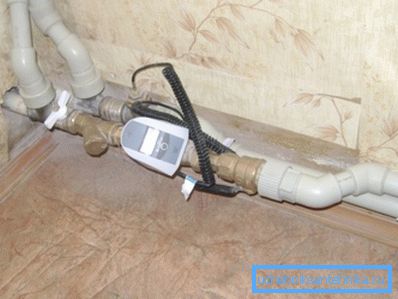
Decor
How to hide heaters, risers and liner? Ideally, it’s better not to do that at all. Any casing on the heating battery will reduce its heat transfer. Frontal panels for radiators that do not impede the movement of convection currents can be a compromise.
Finally, if you still want to install a full-size cover on the heating battery, you should follow a few simple rules.
- Any overlays and covers should pass air.
- Solid shelves on top are not allowed.
- The entire decor should be easily dismantled.
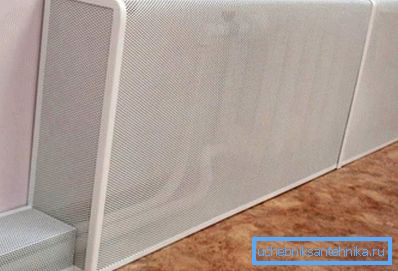
Conclusion
We hope that our review of market offers and recommendations given in the article will be useful to the reader. The attached video will offer him more information. Successes!